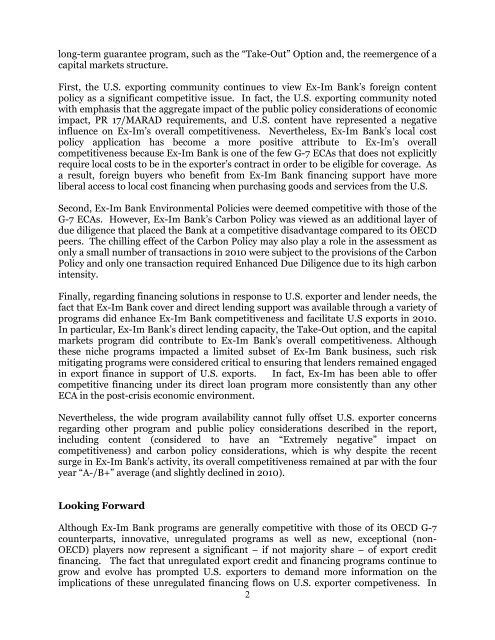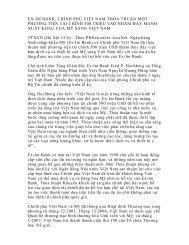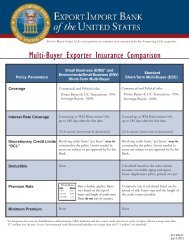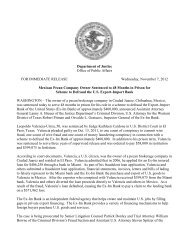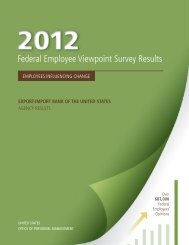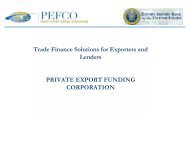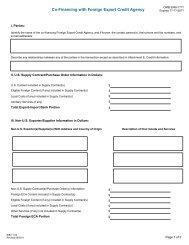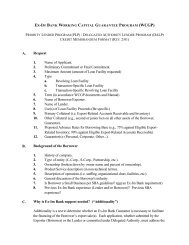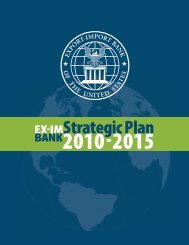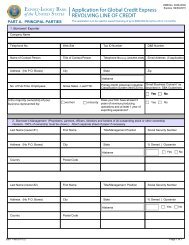2010 Competitiveness Report - Export-Import Bank of the United ...
2010 Competitiveness Report - Export-Import Bank of the United ...
2010 Competitiveness Report - Export-Import Bank of the United ...
Create successful ePaper yourself
Turn your PDF publications into a flip-book with our unique Google optimized e-Paper software.
long-term guarantee program, such as <strong>the</strong> “Take-Out” Option and, <strong>the</strong> reemergence <strong>of</strong> a<br />
capital markets structure.<br />
First, <strong>the</strong> U.S. exporting community continues to view Ex-Im <strong>Bank</strong>’s foreign content<br />
policy as a significant competitive issue. In fact, <strong>the</strong> U.S. exporting community noted<br />
with emphasis that <strong>the</strong> aggregate impact <strong>of</strong> <strong>the</strong> public policy considerations <strong>of</strong> economic<br />
impact, PR 17/MARAD requirements, and U.S. content have represented a negative<br />
influence on Ex-Im’s overall competitiveness. Never<strong>the</strong>less, Ex-Im <strong>Bank</strong>’s local cost<br />
policy application has become a more positive attribute to Ex-Im’s overall<br />
competitiveness because Ex-Im <strong>Bank</strong> is one <strong>of</strong> <strong>the</strong> few G-7 ECAs that does not explicitly<br />
require local costs to be in <strong>the</strong> exporter’s contract in order to be eligible for coverage. As<br />
a result, foreign buyers who benefit from Ex-Im <strong>Bank</strong> financing support have more<br />
liberal access to local cost financing when purchasing goods and services from <strong>the</strong> U.S.<br />
Second, Ex-Im <strong>Bank</strong> Environmental Policies were deemed competitive with those <strong>of</strong> <strong>the</strong><br />
G-7 ECAs. However, Ex-Im <strong>Bank</strong>’s Carbon Policy was viewed as an additional layer <strong>of</strong><br />
due diligence that placed <strong>the</strong> <strong>Bank</strong> at a competitive disadvantage compared to its OECD<br />
peers. The chilling effect <strong>of</strong> <strong>the</strong> Carbon Policy may also play a role in <strong>the</strong> assessment as<br />
only a small number <strong>of</strong> transactions in <strong>2010</strong> were subject to <strong>the</strong> provisions <strong>of</strong> <strong>the</strong> Carbon<br />
Policy and only one transaction required Enhanced Due Diligence due to its high carbon<br />
intensity.<br />
Finally, regarding financing solutions in response to U.S. exporter and lender needs, <strong>the</strong><br />
fact that Ex-Im <strong>Bank</strong> cover and direct lending support was available through a variety <strong>of</strong><br />
programs did enhance Ex-Im <strong>Bank</strong> competitiveness and facilitate U.S exports in <strong>2010</strong>.<br />
In particular, Ex-Im <strong>Bank</strong>’s direct lending capacity, <strong>the</strong> Take-Out option, and <strong>the</strong> capital<br />
markets program did contribute to Ex-Im <strong>Bank</strong>’s overall competitiveness. Although<br />
<strong>the</strong>se niche programs impacted a limited subset <strong>of</strong> Ex-Im <strong>Bank</strong> business, such risk<br />
mitigating programs were considered critical to ensuring that lenders remained engaged<br />
in export finance in support <strong>of</strong> U.S. exports. In fact, Ex-Im has been able to <strong>of</strong>fer<br />
competitive financing under its direct loan program more consistently than any o<strong>the</strong>r<br />
ECA in <strong>the</strong> post-crisis economic environment.<br />
Never<strong>the</strong>less, <strong>the</strong> wide program availability cannot fully <strong>of</strong>fset U.S. exporter concerns<br />
regarding o<strong>the</strong>r program and public policy considerations described in <strong>the</strong> report,<br />
including content (considered to have an “Extremely negative” impact on<br />
competitiveness) and carbon policy considerations, which is why despite <strong>the</strong> recent<br />
surge in Ex-Im <strong>Bank</strong>’s activity, its overall competitiveness remained at par with <strong>the</strong> four<br />
year “A-/B+” average (and slightly declined in <strong>2010</strong>).<br />
Looking Forward<br />
Although Ex-Im <strong>Bank</strong> programs are generally competitive with those <strong>of</strong> its OECD G-7<br />
counterparts, innovative, unregulated programs as well as new, exceptional (non-<br />
OECD) players now represent a significant – if not majority share – <strong>of</strong> export credit<br />
financing. The fact that unregulated export credit and financing programs continue to<br />
grow and evolve has prompted U.S. exporters to demand more information on <strong>the</strong><br />
implications <strong>of</strong> <strong>the</strong>se unregulated financing flows on U.S. exporter competiveness. In<br />
2


